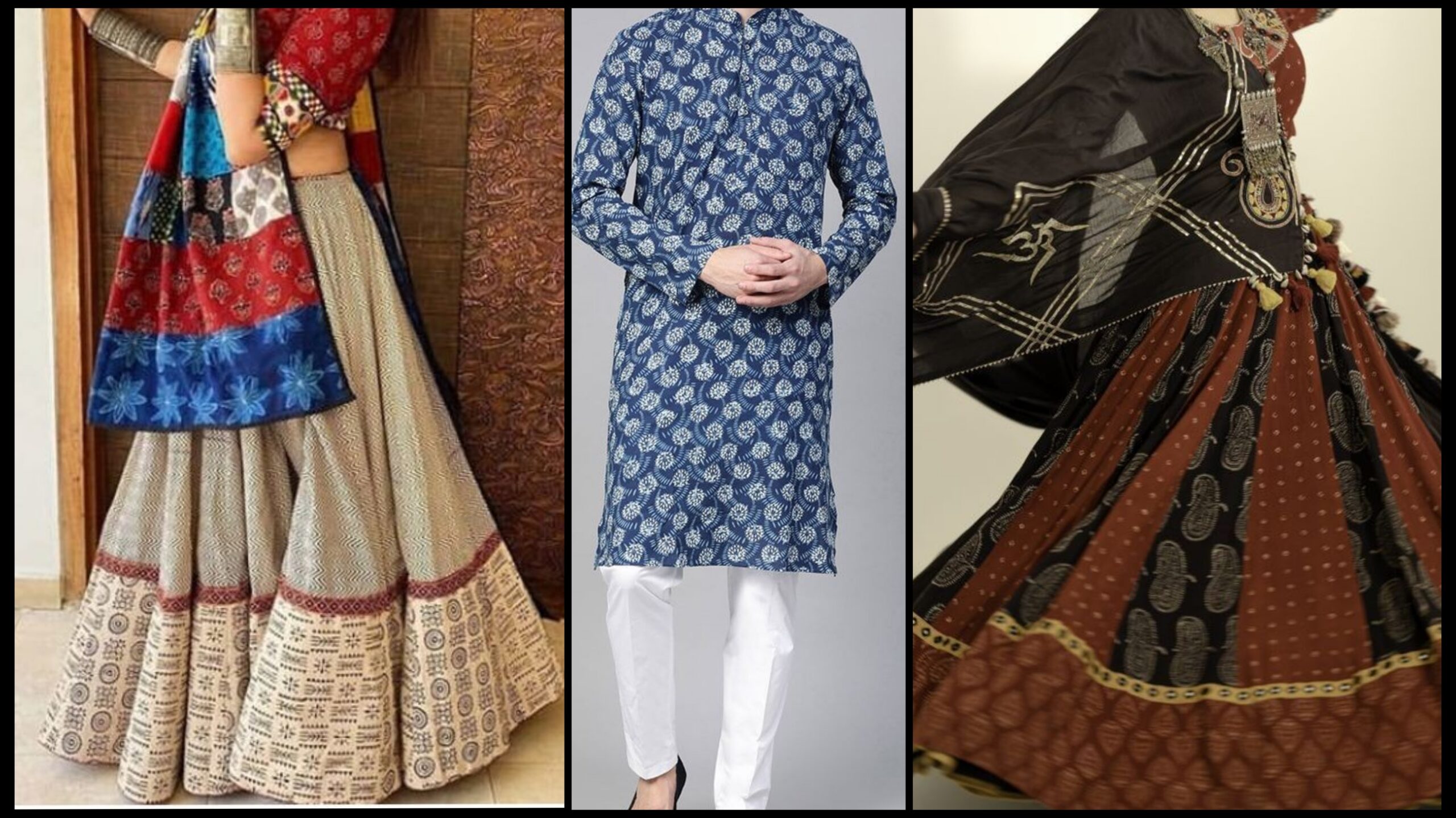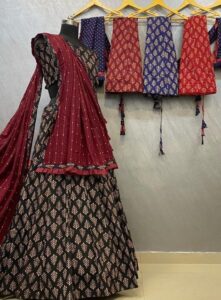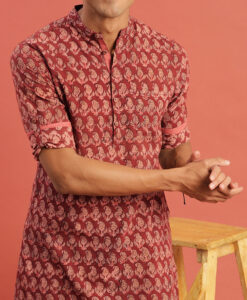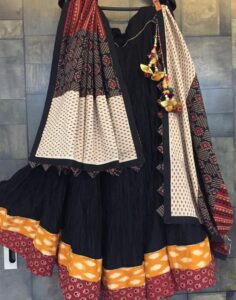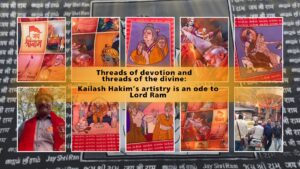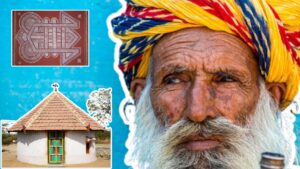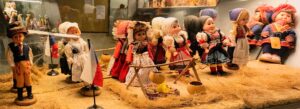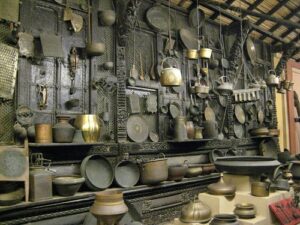It is the fifth day of Navratri today and we have spotted amazing ‘gamthi’ prints on the ground this year. It’s a positive signal of moving back to our roots where block prints and earthy colours were preferred. Let’s delve into the world of ‘gamthi’.
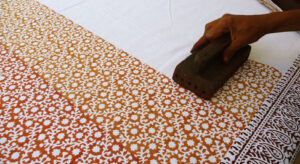 The block print technique known as ‘gamthi’ print originated in medieval India. The title ‘gamthi’ denotes the fact that this art came from the villages of Gujarat and Rajasthan, as the word ‘gaam’ indicates village. Originally, plant materials and metal were employed to generate around 27 distinct sorts of colours, before native people had access to western dyes. It was used to adorn their accessories, including turbans and dupattas, this style of block printing became known as Saudagari prints. Typically, these designs have a recurring pattern that runs the length of the cloth.
The block print technique known as ‘gamthi’ print originated in medieval India. The title ‘gamthi’ denotes the fact that this art came from the villages of Gujarat and Rajasthan, as the word ‘gaam’ indicates village. Originally, plant materials and metal were employed to generate around 27 distinct sorts of colours, before native people had access to western dyes. It was used to adorn their accessories, including turbans and dupattas, this style of block printing became known as Saudagari prints. Typically, these designs have a recurring pattern that runs the length of the cloth.
Emergence
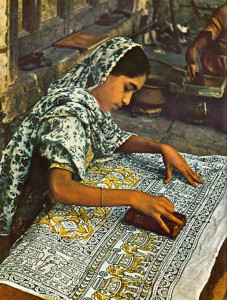 The ‘gamthi’ print, which originated in the villages of Gujarat and Rajasthan, has its roots in the people of these regions rather than in the royal courthouses where many other contemporary designs and costumes were created. As a result, even in those days, they were valued works of art and were sold in huge quantities at the haats (weekly market fares). Fabrics ornamented with this type of block printing were marketed to individuals from all over the Indian subcontinent and eventually the world, in addition to members of the royal families. Since Saudagars (traders) sold them most of the time, this print was also known as a ‘Saudagari’ print which came to be known as ‘gamthi’.
The ‘gamthi’ print, which originated in the villages of Gujarat and Rajasthan, has its roots in the people of these regions rather than in the royal courthouses where many other contemporary designs and costumes were created. As a result, even in those days, they were valued works of art and were sold in huge quantities at the haats (weekly market fares). Fabrics ornamented with this type of block printing were marketed to individuals from all over the Indian subcontinent and eventually the world, in addition to members of the royal families. Since Saudagars (traders) sold them most of the time, this print was also known as a ‘Saudagari’ print which came to be known as ‘gamthi’.
Inspired from?
Gamthi print is known for its use of earthy colours as well as incredibly complex, different patterns in all of its works. This is mostly because nature had a big effect on many of the components utilised in this print. Nature was also the source of the colours that were employed. For example, rusting iron was used to generate black, while turmeric was used to create yellow.
The process
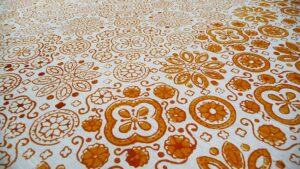 Intricate designs are first engraved on wooden blocks and then colours are added in the process of creating block prints, like ‘gamthi’. To get the desired effect, these designs are then pressed onto the cloth. Block printers exclusively utilise teak wood because it is incredibly robust and resistant to weather, making it the ideal material for carving. This is why block printers seldom use any other wood. This means that a craftsman can reuse a single block as many times as they choose.
Intricate designs are first engraved on wooden blocks and then colours are added in the process of creating block prints, like ‘gamthi’. To get the desired effect, these designs are then pressed onto the cloth. Block printers exclusively utilise teak wood because it is incredibly robust and resistant to weather, making it the ideal material for carving. This is why block printers seldom use any other wood. This means that a craftsman can reuse a single block as many times as they choose.
Diminishing demand
For the past 300 years, the ‘gamthi’ print has been a widely utilised and incredibly popular pattern in the fashion industry. However, over the past several decades, there has been a continuous drop in the number of persons working in this profession due to many new advancements. Because this is one of the places where the wooden blocks needed to make the Gamthi print were made, the Gujarati village of Pethapur is regarded as a centre for block printing and Gamthi printmaking. Though there used to be more than 500 expert artisans working on this technique for centuries every generation, the newer generation prefers to go on to more modern styles and other things, therefore there are currently just a small number of them remaining.
Innovations which upscaled the demands
As one type of printing that is widely connected to India, Gamthi printing is known to be widely available at crafts stores that sell Indian goods, including clothing and artefacts.
In addition to the fashion industry, ‘gamthi’ print is currently utilised in many other industries. For example, it is used to make textured wallpaper, cushion covers, bed spreads, and upholstery, among other home décor products. Combining an ethnic pattern like this with modern or contemporary furniture to create a unique blend of styles is quite trendy.
Bringing it to the ground
Every Navratri season comes with its own trendy colours, while two years back; the primary colours had won people’s heart, last year it was pastels and corals and this year is dominated by the earthy colours. Women are flaunting the 12 mtr gher ghaghra choli while men find their best comfort in cotton ‘gamthi’ print kurtas. Maroon, black, indigo, beige predominantly dominate the ‘gamthi’ colour palette. Floral and geometrical motifs would usually by found on the fabric following a specific symmetry. Paisley is one of the most common style of motifs used during block printing, followed by geometrical shapes.

